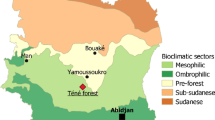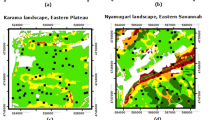Abstract
A phytosociological survey was carried out in the Forest Genetic Reserve of Caçador, which belongs to the Brazilian Agriculture Research Corporation – EMBRAPA. The Genetic Reserve comprises an area of 1120 ha and has been managed by the Agricultural Research and Extension Corporation of the State of Santa Catarina (EPAGRI). A restricted random sampling by plots, with units of 2500 m2 (100 x 25 m) was used, allocating 40 plots to stands containing Araucaria angustifolia. All trees with diameter ≥ 20 cm at breast height were measured. Frequency, density, dominance, soil coverage, and importance value were evaluated, The most important species indicated by these parameters were Araucaria angustifolia, Ocotea porosa, Cupania vernalis, Matayba eleagnoides, Mollinedia elegans, Ocotea pulchella, Ilex paraguariensis and Prunus brasiliensis. In spite of the very high mean basal area (35.84 m2 ha-1), mean density (222 trees ha-1) and mean volume outside bark (531.14 m3 ha-1) for A. angustifolia it was found that understory had low commercial value and a very low natural regeneration rate in the priority species for in situ conservation: A. angustifolia, Cedrela fissilis, I. paraguariensis, Mimosa scabrella, P. brasiliensis and O. porosa. Simpson's index has shown in this case a low floristic diversity of species however, as was expected, the highest levels of abundance, dominance and frequency were found for Araucaria angustifolia.
Similar content being viewed by others
References
Brower, J. E. & Zar, J. H. 1977. Field and laboratory methods for general ecology. 193 pp. Brown Co. Publishers-Iowa.
Campo, J. C. C., Ribeiro, J. C. & Couto L. 1983. Emprego da distribuiç ão diamétrica na determinação da intensidade de corte em matas naturais submetidas ao sistema de seleç ão. Rev. Árvore 7(2): 110-122. (Use of diameter distribution in the determination of cutting intensity in natural forests submitted to selection systems).
Carvalho, J. O. P. 1982. AnÁlise estrutural da regeneraç ão natural em floresta tropical densa na Região de Tapajós. (Tese de Mestrado). 63 pp. UFPR, Curitiba. (Structural analysis of natural regeneration in tropical Rain Forest in Tapajós region.-Msc Thesis).
Croce, D. M. da. 1992. Caracterização espacial, estrutural e fitossociol ógica da Reserva Genética Florestal de Caçador-SC, através da anÁlise de componentes principais e sistemas de informaç ões geogrÁficas. Santa Maria. 120 pp. UFSM. (Tese de Mestrado). (Spacial, structural and phytosociological characteristics of the Forest Genetic Reserve of Caçador - SC, through principal component analysis and geographical information systems).
Finol, U. H. 1971. Nuevos parÁmetros a considerarse en el anÁlisis estructural de las selvas virgenes tropicales. Rev. For. Venez. 14(21): 19-42. (New parameters used in the structural analysis of Tropical Virgin Forests).
Goff, F. G. & West, D. 1975. Canopy understory interactions effect on forest populations structure. For. Sci. 21(2): 98-108.
Goubert Filho, F. A. 1989. Proposta para a criaç ão de um sistema de unidades de conservaç ão da Araucaria angustifoliano estado do ParanÁ. 36 pp., ITCF, Curitiba. (Proposal for the establishment of a system of conservation areas of A. angustifoliain ParanÁ state).
Gurgel Filho, O. A. 1980. Silvica da Araucaria angusfolia (Bert) O. Kzte. In: Problemas florestais do gênero araucaria, 29-68 pp., FUPEF-IUFRO, Curitiba. (A. angustifolia silviculture).
Hueck, K. 1972. As florestas da América do Sul. 466 pp., Poligono, São Paulo. (Forests of South America).
Instituto Brasileiro de Desenvolvimento Florestal, 1978. InventÁrio florestal do pinheiro no sul do Brasil. 327 pp., FUPEF, Curitiba. (Forestry inventory of pine in Southern Brazil).
Instituto Brasileiro de Desenvolvimento Florestal. 1984. InventÁrio florestal nacional:florestas nativas. 309 pp. IBDF, Brasília. (Forestry national inventory: native forests).
Jankauskis, J. 1973. InventÁrio florestal - Cia de papel e celulose lguaçu. In: Congresso florestal brasileiro, 2. Curitiba, 1973. Anais, 160-161 pp., FIEP, Curitiba. (Forestry inventory - Iguaçu paper and cellulose Co.)
Klein, R-M. 1960. O aspecto dinâmico do pinheiro brasileiro. Sellowia 12(12): 17-44. (The dynamic aspects of Brazilian-pine).
Klein R. M. 1980. Aspectos ecológicos do pinheiro brasileiro. In: Problemas florestais do gênero araucaria, 70 pp., FUPEF-IUFRO, Curitiba. (The ecological aspects of Brazilian-pine).
Lamprecht, H. 1962. Ensayo sobre unos métodos para el anÁlisis estructural de los bosques tropicales. Acta Cient. Venez.13(2): 57-65. (Essay on somemethods for structural analysis of Tropical Forests).
Longhi, S. J. 1980. A estrutura de uma floresta natural de Araucaria angustifolia (Bert) O. Ktze. no sul do Brasil. (Tese de Mestrado). 198 pp., UFPR, Curitiba. (The structure or a natural forest of A. angustifolia (Bert.) O. Ktze in Southern Brazil - Msc Thesis).
Machado, S. do A. & Siqueira, J. D. P. 1980. Distribuiç ão natural da Araucaria angustifolia (Bert.) O. Ktze. In: Problemas florestais do gênero araucaria, 4-9 pp., FUPEF-IUFRO, Curitiba (Natural distribution of A. angustifolia (Bert.) O. Ktze.
Reitz, R. & Klein, R. M. 1966. AraucariÁceas. Flora Ilustrada Catarinense. 62 pp., HerbÁrio Barbosa Rodrigues, Itajaí. (Araucareaceae. Illustrated Flora of Santa Catarina).
Roche, L. 1987. Forest genetic resources conservation, Brazil. Bangor (IICA/EMBRAPA Report on three weeks consultancy), 36 pp.
Romariz, D. A. 1973. Tipos de solos e sua utomozaç ão. In: Geografia do Brasil, Grande Região sul. Rio de Janeiro. C. N. G. ppp. 192- 207. (Soil types and their utilization).
Romariz, D. A. 1974. Aspectos da vegetaç ão do Brasil. 59 pp., IBGE, Rio de Janeiro. (Aspects of the vegetation of Brazil.)
Schimidt, H. 1977. Dinâmica de um bosque virgem de Araucaria. Lenga, Bosque 2(1): 3-11. (Dynamics of a virgin forest of Araucaria).
Silva, J. A. da; Leite, E. J. & Gripp, A. 1987. Procedimento para cadastramento e mapeamento de matrizes em reservas genéticas florestais ‘in situ’. (EMBRAPA-CENARGEN. Documentos, No. 10). 25 pp., EMBRAPA/DDT, Brasília. (Procedure for selection and mapping mother-trees in forest genetic reserves.)
Author information
Authors and Affiliations
Rights and permissions
About this article
Cite this article
da Silva, J.A., Salomão, A.N., Gripp, A. et al. Phytosociological survey in Brazilian forest genetic reserve of Caçador. Plant Ecology 133, 1–11 (1997). https://doi.org/10.1023/A:1009767107441
Issue Date:
DOI: https://doi.org/10.1023/A:1009767107441




